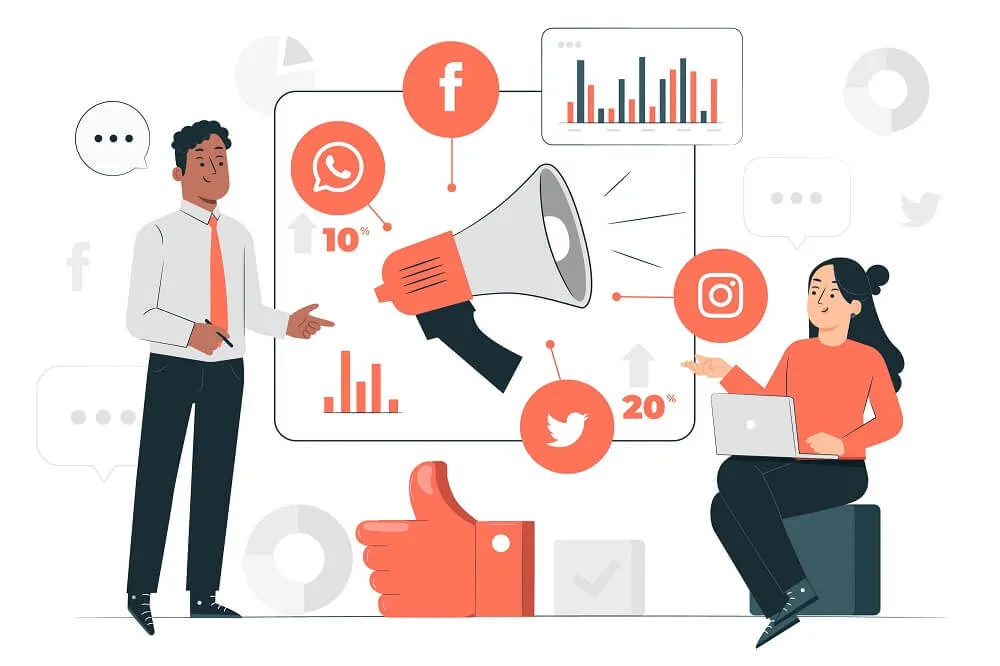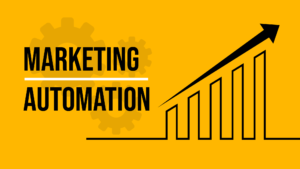Are you an entrepreneur who owns a small business and wants to make your product/service reach a broader audience? Well, I have a perfect idea! What might it be? Spoiler Alert! – Digital Marketing.
Imagine a world where every click, like, or share is a potential customer walking through your doors. That’s the power digital marketing holds for small businesses today. Moreover, in the bustling digital era, small companies find digital marketing an indispensable lifeline to thrive in business.
Digital marketing brings many crucial benefits for small businesses in today’s digital age. It’s the ultimate equalizer, allowing small enterprises and industry giants to stand on the same stage. Through strategic online tactics, businesses, regardless of size, can attract audiences, craft compelling narratives, and carve out their unique space in the digital market.
Stay tuned to explore more about the game-changer – digital marketing for small businesses.
Understanding Digital Marketing Basics
In today’s highly competitive and digital-driven world, digital marketing is not just an option but a necessity. The catalyst pushes small businesses forward, opening doors to unlimited possibilities and paving the way for sustained growth and success.
- Levelling the Playing Field: Digital marketing eliminates the size barrier by enabling small businesses to compete face-to-face with larger industry counterparts on a global platform. Small businesses can create impactful campaigns, reach their target audience, establish a solid online presence, and capture a market share, regardless of budget constraints.
- Cost-Effective Reach: Traditional marketing alley often has a hefty price tag that small businesses cannot offer. Digital marketing, on the other hand, offers cost-effective strategies. Digital platforms like social media, content marketing, and email campaigns allow businesses to reach a larger audience at a lower cost, ensuring that every penny spent contributes to a tangible return on investment.
- Targeted Engagement: Identifying and reaching the right audience is vital for small businesses. Digital marketing provides tools and analytics that allow meticulous targeting based on demographics, behaviors, interests, and more. This targeted approach ensured that the business’s message resonated with those most likely to convert, leading to higher engagement and increased conversions.
- Real-Time Adaptability: In today’s fast-paced marketplace, flexibility is crucial. Based on performance metrics, digital marketing strategies can be adapted and optimized in real-time. This flexibility allows small businesses to swiftly adjust their approach, exploit trends, and refine their campaigns for maximum results, keeping them ahead of the competitive landscape.
- Enhanced Brand Visibility and Authority: A solid online presence is crucial for brand recognition. Digital marketing channels like SEO, content marketing, and social media enable small businesses to build brand awareness, establish authority in their niche, and foster trust with their audience, ultimately leading to increased credibility and customer loyalty.
- Measurable Results: Unlike traditional marketing methods, where evaluating success can be challenging, digital marketing offers comprehensive analytics and metrics. This agility enables businesses to track every aspect of their campaigns, measure performance, identify what works best, and make data-driven decisions to optimize their strategies continually.
Building a Strong Online Presence
Incorporating SEO, particularly local SEO strategies, into the digital marketing armory of small businesses is crucial. It’s the doorway inviting your potential customers, elevating your visibility, credibility, and, ultimately, your bottom line.
Importance of SEO for Visibility:
- Enhanced Visibility: SEO boosts your website’s visibility in search results, making it easier for potential customers to find your business online.
- Credibility and Trust: Higher rankings build credibility, fostering user trust and potentially increasing traffic and conversions.
- Improved User Experience: SEO involves optimizing your site for a better user experience, which can lead to increased engagement and satisfaction.
Leveraging Local SEO for Small Businesses:
- Geographically Targeted Reach: Local SEO ensures your business appears in local searches, attracting nearby customers.
- Google My Business Optimization: Optimizing your Google My Business profile enhances visibility on Google Maps and Local search results.
- Community Engagement: Engaging with the local community through directories, events, and social media fosters trust and loyalty.
- Competitive Edge: Local SEO allows small businesses to compete effectively against giant corporations by targeting specific local keywords and audiences.
Social Media Marketing
Choosing the right platforms and creating engaging content tailored to your audience’s preferences is crucial and can effectively boost your online presence and connect with your target customers in meaningful ways.
Choosing the Right Platforms for Your Small Business:
- Know Your Audience: Firstly, understand your target audience’s demographics, preferences, and behaviors, then choose platforms where your audience is most active. For instance, LinkedIn might be more effective if your audience comprises professionals than Instagram.
- Platform Relevance: Analyze the nature of your business and connect with the platforms that align well. Visual businesses thrive on visually-rich platforms like Instagram or Pinterest, while B2B services often succeed on LinkedIn.
- Competitor Analysis: Look at where your competitors have a strong presence. Analyze their engagement and assess whether those platforms could benefit your business.
- Resource Allocation: Consider the resources required to maintain a presence on various platforms, and choose platforms that align with your available resources in terms of time, budget, and human resources.
- Test and Repeat: Experiment with different platforms initially to assess their effectiveness. Analyze metrics like engagement rates, conversion, and audience growth. Adjust your strategy based on what works best for your business.
Tips for Creating Engaging Content:
- Know Your Audience’s Pain Points: Address your audience’s needs, challenges, and interests through your content. Provide solutions, advice, or entertainment that oscillates with your audience.
- Quality Over Quantity: Focus on creating high-quality, valuable content rather than agitating numerous posts. Your content should be informative, entertaining, or educational, capturing the audience’s attention and encouraging interaction.
- Visual Appeal: Visual elements like images, videos, infographics, and gifs enhance content engagement. Use them strategically to complement your message and make it more compelling.
- Consistency is Key: Maintain a consistent posting schedule to keep your audience engaged and interested.
- Encourage Interaction: Prompt your audience to engage with your content by asking questions, conducting polls, hosting content, or encouraging user-generated content. Respond promptly to comments and messages to foster a community around your brand.
- Stay Authentic: Be genuine and transparent in your content. Authenticity builds trust and fosters stronger connections with your audience.
Email Marketing Strategies
Building an Email List: Tips and Techniques:
- Opt-in Forms: Create attractive opt-in forms offering incentives for sign-ups.
- Content Upgrades: Offer exclusive content accessible only through email subscription.
- Lead Magnets: Develop appealing resources addressing audience pain points in exchange for emails.
- Optimized Landing Pages: Design dedicated pages with clear CTAs for email sign-ups.
- Social Media Promotion: Use social platforms to promote email sign-ups.
- Events and Webinars: Require email registration for access to workshops or events.
Crafting Effective Email Campaigns:
- Personalization: Segment and personalize content based on subscriber preferences.
- Compelling Subject Lines: Craft attention-grabbing subject lines to increase open rates.
- Valuable Content: Provide relevant and engaging content aligned with subscriber’s interests.
- Mobile Optimization: Ensure emails are mobile-friendly for better accessibility.
- Clear CTAs: Include clear and compelling CTAs for desired actions.
- Testing: Experiment and optimize email elements through testing for better performance.
Content Marketing for Small Businesses
Each content type has its unique cause in reaching and engaging with the audience. By diversifying content across various formats, small businesses can cater to different preferences, maximize audience reach, and effectively communicate their brand message, ultimately boosting their online presence. Here’s the importance of quality content and diverse content types:
Importance of Quality Content:
- Establishing Credibility and Authority: High-quality content showcases expertise, establishing credibility within the Industry. It positions the business as a trusted source of information, enhancing authority and trust among the audience.
- Enhanced Engagement and Audience Connection: Quality content resonates with the audience, sparking interest and fostering engagement. It encourages interaction, discussions, and sharing, building a stronger connection between the brand and its audience.
- Improved SEO and Online Visibility: Search engines prioritize quality content. Well-crafted, informative content with relevant keywords enhances SEO, boosting visibility in search engine rankings and attracting organic traffic.
- Building Brand Awareness and Loyalty: Compelling content educates, entertains, or solves problems for the audience. Consistently delivering valuable content reinforces brand awareness and loyalty, keeping the brand top-of-mind.
Diverse Content Types:
- Blogging: Blogs are an effective way to provide in-depth information, insights, and updates related to the Industry. They improve SEO, drive traffic to the website, and position the business as an authority in the Industry.
- Videos: Video content is highly engaging and shareable. It allows businesses to convey information in a visually appealing and easily understandable format. Videos can range from tutorials and product demonstrations to behind-the-scenes glimpses, catering to varied audience preferences.
- Infographics: Infographics condense complex information into visually compelling graphics. They are eye-catching, easy to understand, and perfect for explaining statistics, processes, or comparisons. Infographics often get shared widely across social media platforms, expanding the brand’s reach.
Paid Advertising Options
PPC Advertising: PPC advertising is a model where advertisers pay a fee each time their ad is clicked. Google Ads and Bing Ads are popular PPC advertising platforms where advertisers bid for ad placement in a search engine’s sponsored links.
Social Media Advertising: Social media ads are paid advertisements served to users on social media platforms such as Facebook, Instagram, Twitter, LinkedIn, and others. These ads can be sponsored posts, videos, or stories, targeting specific demographics, interests, or behaviors of users.
Tracking and optimizing Ad Performance:
- Key Metrics: Track metrics like click-through rate (CTR), conversion rate, cost per click (CPC), cost per conversion, and return on ad spend (ROAS) to assess the effectiveness of your ads.
- A/B Testing: Experiment with ad creatives, copy, targeting options, and calls to action to identify what works best for your audience.
- Ad Schedule Optimization: Analyze when your ads perform best and schedule them accordingly to maximize their effectiveness.
- Use Analytics tools: Platforms like Google Analytics and social media insights provide valuable data to understand user behavior and fine-tune your ad strategies.
Conclusion
In today’s modern world, Digital marketing is not just a choice but a necessity for small businesses. It allows smaller businesses to reach and engage their audience effectively. Businesses can connect with their customers personally, fostering loyalty and growth through digital channels like social media, SEO, and targeted campaigns.
Digital marketing plays a predominant role and is the doorway for small businesses to succeed by providing real-time analytics and guiding informed decisions for maximum impact. For small companies, accepting these strategies isn’t just about staying relevant but seizing opportunities.
It’s time to start or enhance your digital presence – embrace this landscape and watch your business flourish in ways you’ve never imagined. The potential within the digital realm is vast; take that first step and unlock boundless opportunities for your small business.




Pingback: buy cheap enclomiphene where to purchase
Pingback: kamagra vente par correspondance
Pingback: order androxal buy adelaide
Pingback: buy cheap flexeril cyclobenzaprine generic release date
Pingback: how to order dutasteride no rx needed
Pingback: cheap gabapentin generic pricing
Pingback: ordering fildena generic fildena
Pingback: purchase itraconazole cheap united states
Pingback: staxyn canada free sample
Pingback: avodart singapore buy
Pingback: cheap xifaxan cost uk
Pingback: how to order rifaximin price usa
Pingback: kamagra žádný lékař